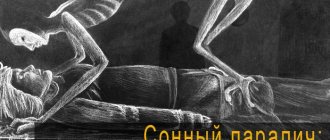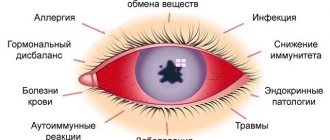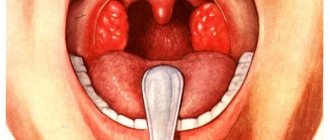Myasthenia gravis is a disease that is characterized by a violation of neuromuscular transmission (that is, a violation of the process of muscle contraction that occurs in response to an impulse traveling along a nerve fiber). The cause of myasthenia gravis is often an autoimmune process, as a result of which the body produces antibodies to the structures of the neuromuscular synapse. According to statistics, myasthenia gravis occurs in every 5 out of 100 thousand people. It is a chronic disease with acute or gradual onset. The main manifestation is transient muscle weakness; ptosis (drooping) of the upper eyelids, impaired swallowing, and a “nasal” voice may also occur. In severe cases and as the disease progresses, weakness of the respiratory muscles may occur, including respiratory arrest.
The dangerous disease progresses rapidly, clinical manifestations may subside and worsen again. Pathological muscle fatigue is diagnosed more often in women than in men, and much less often in children. The average age of patients is from 15 to 45 years, thus, the maximum number of cases is registered in the most active part of the population.
At CELT you can get advice from a neurologist.
- Initial consultation – 4,000
- Repeated consultation – 2,500
Make an appointment
Symptoms of Myasthenia Gravis
Symptoms of myasthenia gravis are very diverse, which often leads to late diagnosis of the disease and erroneous diagnoses.
Drooping of the upper eyelid (ptosis)
Often the first manifestations of the disease are ptosis. It can be either one-sided or two-sided. May be asymmetrical and change throughout the day. More often in the morning and after rest it is less pronounced, and in the evening and after exercise it intensifies. Maybe on one side or the other.
Double vision can occur periodically when the condition worsens, or it can be constant when the disease is severe. It also intensifies with any physical activity, bright light, or heat. Decreases in the morning and after rest.
Weakness of the facial muscles is one of the most common symptoms of the disease. The muscles of the upper half of the face are most affected, which leads to difficulty closing their eyes; sometimes patients with severe disorders cannot even close their eyes completely. It can also be difficult to puff out your cheeks; facial expressions and smiles change. When trying to smile, only the upper lip rises, while the lower lip and the corners of the mouth remain motionless. There may be difficulty chewing, especially hard foods, and sometimes patients have to support their jaw with their hand while eating.
Impaired swallowing and changes in voice are also quite common symptoms; the voice becomes quiet, with a nasal tint, difficulties may arise when pronouncing the sounds “r”, “b”, “p”, “d” and “t”, choking occurs when taking food. The severity of symptoms can also change; they intensify during exercise and decrease after rest. Eating hot food often leads to a worsening of the condition. Severe disturbances can lead to changes in appetite and weight loss. And with severe lesions of the laryngeal muscles, patients speak almost in a whisper. Sometimes, when the condition worsens, it is necessary to resort to tube feeding if the patient cannot swallow on his own.
Weakness of the muscles of the neck and limbs are very common symptoms in the generalized form. Moreover, the muscle groups that are responsible for straightening the limbs suffer more. Weakness increases in the early stages with prolonged static load and repeated small movements (combing and styling hair, washing, knitting, working on a conveyor belt). In more severe cases of the disease, even with single movements. Patients may find it difficult to dress, wash, get up from a chair, and have difficulty climbing stairs. Weakness of the neck muscles can be so severe that the head hangs and it is difficult for the patient to lift it. Often, in severe cases, outside help is required.
Breathing disorders are the most formidable and dangerous symptom of myasthenia gravis. It is difficult for the patient to take a breath; there may be an accumulation of thick and viscous saliva, which is difficult to spit out and swallow. Shortness of breath can occur with exertion, and in more severe cases, at rest.
With myasthenia gravis, some patterns are observed:
- individual muscles are predominantly damaged;
- change in the severity of symptoms (all symptoms can vary greatly over several days, hours; the condition can worsen with exercise, menstruation, concomitant diseases, changing weather conditions);
- improvement of the condition after rest and taking medications that improve the conduction of nerve impulses.
Sometimes a patient's condition can suddenly deteriorate sharply - a crisis occurs. During a crisis, severe muscle weakness is observed, swallowing and breathing are impaired. This condition requires emergency care.
There are 3 types of crises: myasthenic, cholinergic and mixed.
Myasthenic - is essentially a pronounced increase in the symptoms of myasthenia. Movement disorders increase, and breathing disorders of varying severity are noted. This type of crisis develops with inadequate treatment of myasthenia gravis, insufficient doses of drugs, and excessive physical activity.
Cholinergic - associated with an overdose of drugs used in the treatment of the disease (Kalimin, proserin). It also manifests itself as increased muscle weakness, breathing problems, swallowing problems, and the formation of large amounts of liquid saliva.
Mixed - this type is most often encountered in practice, since when the condition worsens, patients independently increase the dose of drugs, which leads to their overdose and worsening of the condition. The symptoms are similar: a significant increase in muscle weakness, difficulty swallowing, and breathing.
To treat crises, plasmapheresis, glucocorticoids, and intravenous immunoglobulin are used.
Severe breathing disorders often require artificial ventilation, when the patient cannot breathe on his own, the machine does this for him.
In order to avoid such severe complications, it is very important to strictly follow the doses of medications prescribed by your doctor and the intervals between taking them.
Myasthenic crisis
As clinical practice shows, myasthenia gravis is a progressive disease, which means that under the influence of certain paralysis factors (external environment or endogenous causes), the degree and severity of symptomatic manifestations of the disease can increase. And even patients with mild myasthenia gravis can experience a myasthenic crisis.
The cause of this condition may be:
- injuries;
- stressful conditions:
- any acute infections;
- taking medications with neuroleptic or tranquilizing effects;
- surgical interventions in the body, etc.
Symptoms are manifested by the first appearance of double vision. Then the patient feels a suddenly increasing attack of muscle weakness, the motor activity of the muscles of the larynx decreases, which leads to disruption of the processes:
- voice formation;
- breathing and swallowing;
- salivation increases and the pulse quickens;
- The pupils may dilate, tachycardia may occur, and complete paralysis may occur without loss of sensitivity.
The development of acute insufficiency of oxygen supply to the brain can lead to a direct threat to life, so resuscitation measures are urgently necessary.
Causes of the disease
Skeletal muscles begin to work when they receive a nerve impulse. The transmission of impulses from nerve to muscle occurs in a special formation called a synapse. The synapse has receptors to which acetylcholine attaches - this is a special substance that is released at the synapse when it receives a nerve impulse. The connection of acetylcholine with receptors serves as a signal for muscle contraction. This happens normally.
With myasthenia gravis, the number of active receptors is reduced, the muscle cannot work normally, and fatigue occurs. Damage and inactivation of receptors are caused by antibodies produced by the patient's immune system. Normally, the immune system produces antibodies to protect against foreign cells, but with myasthenia gravis this mechanism is disrupted, and instead of protecting, the immune system begins to attack its own tissues. The exact reasons for the malfunction of the immune system are still not known. Presumably the root cause may be infection, metabolic disorders, stress, pregnancy and childbirth, etc. Myasthenia gravis can be combined with other autoimmune diseases. Myasthenia gravis is not inherited.
Diet therapy and lifestyle correction
For patients with myasthenia gravis, neurologists prescribe special diet therapy. Its goal is to increase the protective function of the body. Dishes should contain large amounts of potassium, phosphorus, calcium and vitamins.
Fatty and fried foods, smoked foods, and canned foods are excluded from the menu. Patients are advised to stop drinking alcohol. Patients should also follow the following doctor's recommendations:
- To refuse from bad habits;
- Control body weight;
- Reduce time spent in direct sunlight;
- Avoid physical and emotional overload;
- Alternate work with rest.
Without consulting a doctor, patients with myasthenia gravis should not take the following medications: diuretics, fluoroquinols, tranquilizers, antipsychotics, drugs containing fluoride, magnesium, quinine.
Forms of Myasthenia
There are different classifications of myasthenia gravis.
According to the type of flow, they are distinguished:
- Myasthenic episodes;
- Myasthenic conditions;
- Progressive;
- Malignant;
According to the prevalence of the process:
- Ocular, in which exclusively the eye muscles are affected.
- Bulbar - manifested by voice and swallowing disorders.
- Generalized, in which various muscle groups are affected and it, in turn, is divided into various forms: without bulbar disorders, with bulbar disorders, with breathing disorders.
By severity of violations:
- Lightweight;
- Moderate;
- Heavy;
Diagnostics
In making a diagnosis of myasthenia gravis, it is of great importance whether the patient has had episodes of weakness and fatigue in the past, which completely or partially resolved on their own or with nonspecific treatment. Most often, the eye muscles are affected - double vision occurs, the eyelids droop; facial muscles - facial expressions and smile change. Less commonly observed are problems with swallowing, voice, and weakness of the muscles of the limbs and neck.
The presence of a mediastinal tumor is also important, which is sometimes detected by chance during radiography, CT or MRI. Although the mere fact of the presence of a tumor does not confirm the diagnosis of myasthenia gravis. To make a diagnosis, a neurologist must conduct a full examination. Muscle strength, sensitivity, coordination of movements, swallowing, voice, etc. are assessed. Special tests are carried out to detect muscle fatigue. In mild cases, muscle weakness is detected when certain movements are repeated; in severe cases, the presence of weakness can be seen even without load.
Proserine test
One of the most important criteria for making a diagnosis is a test with Proserin. The drug is administered subcutaneously or intramuscularly in a dose of 1 ml to 2 ml, depending on the patient’s body weight. The result is assessed 40-90 minutes after administration of the drug.
Complete restoration of muscle strength is observed in a small number of patients; the majority experience incomplete improvement; this is regarded as a positive test. If there is a slight improvement, the test is considered doubtful, and if there is no effect, it is considered negative.
Blood analysis
All patients with suspected myasthenia gravis need to determine the level of antibodies to the acetylcholine receptor in the blood serum. To do this, blood is taken from a vein. This indicator is very important for making a diagnosis and assessing the effectiveness of treatment. Normally, the antibody level does not exceed 0.45 nmol/l. In specialized centers, antibodies to non-muscle-specific tyrosine kinase, titin and ryanodine receptors, which are often detected in the blood of patients with a thymus tumor, are also determined. But there are also seronegative forms, when antibodies are not detected in the blood
Electromyography
A very important method in diagnosing myasthenia gravis is electromyography, which detects disturbances in the conduction of impulses from nerve to muscle. The doctor places electrodes on the muscle and stimulates it with electrical impulses, this allows you to identify muscle fatigue.
The forms of myasthenia gravis are very diverse, so when conducting an examination of each patient, the doctor individually chooses which muscles to examine. The most affected muscle is selected. It makes no sense, for example, if eye movement is impaired, to examine the muscles of the arms. It is recommended to conduct the examination without taking medications, as the result may be unreliable. This examination method is often combined with a proserine test.
Computed or magnetic resonance imaging of the mediastinum
In the development of myasthenia gravis, the condition of the thymus gland plays a significant role; its enlargement or even tumors are often detected. Therefore, patients with myasthenia gravis are necessarily prescribed CT or MRI of the mediastinum.
In some cases, for a more accurate diagnosis, the level of thyroid hormones and glycosylated hemoglobin are examined. Since diseases of the thyroid gland and diabetes mellitus may cause symptoms resembling myasthenia gravis.
Treatment of Myasthenia Gravis
Various drugs and treatment methods are used in the treatment of myasthenia gravis. The choice of therapy depends on the form and severity of the disease.
The use of drugs that block the cholinesterase enzyme (Proserin, Kalimin, Pyridostigmine bromide) is aimed at improving the conduction of impulses from the nerve to the muscle and, accordingly, reducing muscle weakness. Proserin lasts only 2-4 hours, so it is used for testing and in cases where a quick onset of action of the drug is necessary. Kalimin (Pyridostigmine bromide) begins to act only after 45-60 minutes, but the effect can last up to 6-8 hours. Therefore, kalimine is more often used for continuous use. The interval between doses of the drug should be at least 5-6 hours; more frequent use can lead to an overdose. An overdose is manifested by drooling, muscle twitching, dizziness, etc.
Doses of all drugs are selected individually in consultation with a doctor.
These drugs help to temporarily improve the condition, but do not act on the cause of the disease. Therefore, they are used in milder cases of the disease.
If the effect of taking Kalimin is insufficient or the condition worsens, especially in the presence of swallowing and breathing problems, drugs are prescribed that affect the functioning of the immune system and reduce the production of antibodies (glucocorticoids and cytostatics).
Glucocorticoids (Prednisolone, Methylprednisolone) are effective in most patients, so they are considered the most basic drugs in the treatment of severe forms with swallowing, breathing and ocular disorders. Their use allows you to achieve quick results.
The dose of the drug is selected individually, depending on the severity of the patient’s condition. On average it is 1 mg/(kg/day). The drug is taken once a day in the morning, daily or every other day. The effect is assessed after a few days. As the condition improves, the dose of prednisolone is gradually reduced to a maintenance dose, which sometimes has to be taken for a long time.
If the effect of hormonal drugs is insufficient or pronounced side effects are observed: increased blood pressure, blood sugar, ulcerative lesions of the stomach and intestines, etc., cytostatics (Azathioprine, Sandimmune, etc.). Doses of these drugs are selected individually under the control of a blood test.
Potassium preparations
Potassium is involved in the conduction of nerve impulses and helps improve the condition of patients with myasthenia gravis. potassium chloride powder or tablets, 1 g 3 times a day with meals. (Kalinor retard, Potassium normin, Kalipoz). To increase the level of potassium in the blood, potassium-sparing diuretics are also used: Spironolactone (Veroshpiron).
RADIATION THERAPY - usually given to elderly patients with serious underlying medical conditions for which surgery cannot be performed.
NON-SPECIFIC THERAPY is most often carried out in spring and autumn, when exacerbations usually occur, in courses of 2-3 months. Treatment helps improve the functioning of the nervous system and increase the body's resistance. It includes drug treatment and hardware methods (ILBI, blood ozonation, etc.), the full range of which is presented at the First Neurology clinic.
Forecast
With timely contact with specialists, the patient receives effective treatment, allowing to achieve stable remission, without exacerbations and myasthenic crises. And in some cases, a complete cure is possible. Refusal of medical assistance can lead to disastrous consequences.
Make an appointment with CELT neurologists at a time convenient for you. The clinic has everything necessary to conduct high-quality diagnostics. Experienced specialists will conduct the necessary research and select adequate therapy.
Make an appointment through the application or by calling +7 +7 We work every day:
- Monday—Friday: 8.00—20.00
- Saturday: 8.00–18.00
- Sunday is a day off
The nearest metro and MCC stations to the clinic:
- Highway of Enthusiasts or Perovo
- Partisan
- Enthusiast Highway
Driving directions
Pregnancy with Myasthenia Gravis
Pregnancy with myasthenia gravis is not contraindicated. Patients with myasthenia gravis are able to safely carry a pregnancy to term. The only limitation for pregnancy with myasthenia gravis is an insufficiently compensated condition with severe symptoms.
In 1/3 of patients, deterioration of the condition may be observed, more often in the 1st trimester and the first month after childbirth.
Taking medications must be continued during pregnancy (Kalimin and Glucocorticoids). With the exception of cytostatics (Azathioprine, Sandimmune, etc.), pregnancy while taking them is undesirable.
It is advisable to plan pregnancy during the period of remission. During pregnancy, patients must be observed by a neurologist for timely correction of treatment.
Artificial termination of pregnancy in myasthenia gravis is contraindicated, as it almost always leads to an exacerbation of the disease.
Childbirth in the absence of obstetric indications, preferably through the natural birth canal. Sometimes during childbirth additional administration of Kalimin (Proserin) and Oxytocin is required. If there are indications for cesarean section, preference is given to epidural anesthesia.
20% of newborns may experience symptoms of myasthenia gravis, this is due to the transfer of antibodies from the mother. Symptoms: lethargy of the child, weak cry, ptosis, breathing problems, as a rule, can persist from 2 to 4 weeks and disappear as the antibodies are destroyed. This requires careful monitoring of the newborn, in some cases the use of drugs (Kalimina) is required.
Danger
Myasthenia gravis is an insidious disease. Among its complications:
- A sharp increase in muscle fatigue, leading to breathing problems (the patient may suffocate).
- Dysregulation of the heart (possible cardiac arrest).
During pregnancy, myasthenia gravis may either temporarily stop progressing or, on the contrary, lead to an increase in the number of affected muscles. To exclude dangerous complications, a woman should be observed by a neurologist for all nine months.
Recommendations for a patient with Myasthenia gravis
Myasthenia gravis is a serious disease that requires increased attention and has many features and restrictions, which, if not observed, can easily provoke a deterioration of the condition.
With myasthenia gravis, significant physical activity and prolonged exposure to the sun are contraindicated. Deterioration can also be caused by staying in a sauna or steam room.
Many medications are contraindicated:
- Magnesium preparations;
- Curare-like muscle relaxants;
- Neuroleptics and tranquilizers (except tofisopam);
- Diuretics (except spironolactones);
- Many antibiotics: aminoglycosides (gentamicin, streptomycin, kanamycin, tobramycin, sisomycin, amikacin, etc.), fluoroquinolones (norfloxacin, ciprofloxacin, ofloxacin, etc.);
- Fluorinated corticosteroids (Dexamethasone, Dexazone, Polcortolone);
- Quinine derivatives;
- Penicillamine;
- B-blockers;
- Calcium channel blockers;
- Carbamazepine;
- Oral contraceptives;
- Narcotic analgesics.
Read also
Rehabilitation after stroke
It is very important to begin rehabilitation after a stroke as early as possible, since further recovery and the ability to avoid disability depend on this.
For rehabilitation after a stroke in the clinic “First… Read more
Vertebral artery syndrome
The main vascular highways carrying blood to the brain pass in the neck - these are two carotid and two vertebral arteries. A decrease in blood flow through the vertebral arteries will lead to the development of acute...
More details
Neuropathy
In the human body, the work of internal organs and systems is regulated by the brain, namely by nerve impulses emanating from it. These impulses travel along nerve fibers. Damage to them can damage this...
More details
Perinatal encephalopathy
Perinatal encephalopathy is a frequently encountered concept in the practice of pediatricians and pediatric neurologists! What it is? Literally, “perinatal encephalopathy” means “damage to the brain in the perinatal...
More details
Atherosclerosis
Atherosclerosis is a vascular disease that is caused by a decrease in the elasticity of the vascular wall, the deposition of cholesterol on the inner surface and, as a result, the appearance of atherosclerotic plaques. Atherosclerosis…
More details









